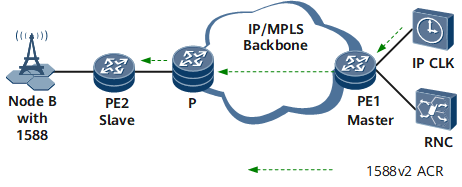Configuring 1588 ACR in Single-Server Mode
In one 1588 ACR domain, a client initiates a request for negotiation, and exchanges Layer 3 unicast packets with the server to set up a connection. The client exchanges 1588v2 packets with the server over the connection to restore clock information.
Applicable Environment
On the IP RAN shown in Figure 1, two PEs are connected by a Layer 3 network deployed with 1588v2-unaware devices. PE1 attached to an RNC is connected to a BITS. 1588 ACR-capable PE2 initiates a request for negotiation and exchanges Layer 3 unicast packets with PE1 to set up a connection. If the connection is successful, PE2 exchanges 1588v2 packets with PE1 over the connection to implement clock synchronization.
Pre-configuration Tasks
Before configuring 1588 ACR in single-server mode, complete the following tasks:
Configuring static routes or configuring an IGP to ensure that IP routes between nodes are reachable
Ensuring that the clock server has correctly imported clock signals from a BITS
- The license file on the main control board has been activated by running the license active file-name command. When the clock synchronization license is not loaded, the ptp-adptive enable configuration is not allowed.
- Configuring the Unicast Negotiation Function for a Client
- The unicast negotiation function and parameters for a connection between a client and a clock server are configured on the router functioning as a 1588 ACR client.
- Configuring the Unicast Negotiation Function for a Server
- The unicast negotiation function and parameters for a connection between a client and a clock server are configured on the router functioning as a 1588 ACR clock server.
- (Optional) Adjusting Parameters for Establishing a Unicast Negotiation Connection
- Adjustable parameters include the maximum number of consecutive Announce packets that the client fails to receive (If the number of unreceived Announce packets exceeds the threshold, the client determines that the connection to the server fails), duration of the Sync, Delay_Resp, and Announce packets (After the duration of a Sync packet, a Delay_Resp packet, or an Announce packet expires, the client re-establishes the connection with the server), DSCP value (the DSCP value ensures that 1588v2 packets reach the destination even if a congestion occurs on the network), and the interval at which the server sends Sync, Delay_Resp, and Announce packets.
- Verifying the Configuration of 1588 ACR
- After configuring 1588 ACR on the router, verify the configuration.
